IMAGINARY FRIENDS (5)
By:
August 29, 2017
One in a series of ten posts reprinting HILOBROW friend Alexandra Molotkow’s profiles of figures who’ve loomed large in her personal pantheon.
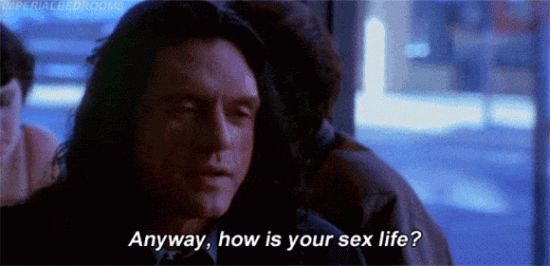
Originally appeared in Hazlitt, Oct 10 2013.
Greg Sestero first encountered Tommy Wiseau — his future director in The Room, the “greatest bad movie ever made” — at an acting class in San Francisco. The class was ready to dismiss, when a man with jet-black curls and a face like a mangled Fabio strolled onstage, slammed down a chair, straddled it, and announced he’d be performing Shakespeare’s Sonnet 116. “It suddenly seemed possible this guy was actually sort of great,” writes Sestero, with help from Tom Bissell, in The Disaster Artist, a memoir of their ensuing relationship. “No one who wasn’t great could afford to conduct himself like this.” And Wiseau was great, in a way: “Everything he said was obviously the product of diligent mismemorization, totally divorced from the emotion the words were trying to communicate. He was terrible, reckless, and mesmerizing.”
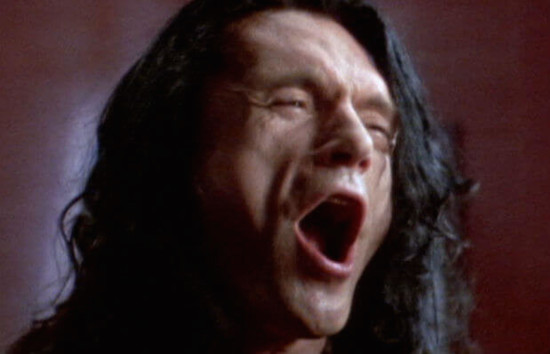
It’s a very fine line between the stupid and the poetic. Consider this scene: On May 4, 1970 — the day members of the Ohio National Guard opened fire on student demonstrators at Kent State, killing four — Leonard Cohen was performing in Hamburg when, “as some kind of convoluted anti-authority peace gesture,” he decided to click his heels and give the Nazi salute. The crowd nearly rioted; one man rushed the stage with a gun. Cohen picked up his guitar, and said, “‘Are you finished, are you all through?’ and they applauded as he started playing,” Bob Johnston tells Sylvie Simmons in her Cohen biography, I’m Your Man. “‘But it was an old Yiddish song. And he started dancing on one leg across the stage like Jews do, singing ‘Ai-eee, ai-eee,’ and they started cursing and throwing things again. Then he started one of his own songs and we all joined in,’” and the crowd, as if by magic, quieted down. “‘Leonard was always pulling stunts like that, and getting away with it.’”
I’m not equating Tommy Wiseau and Leonard Cohen as artists, only comparing their audacity; sometimes, conviction can make all the difference. “I accept that Tommy Wiseau is some kind of artist, even some kind of amazing artist,” Bissell told The Rumpus in an interview about his nonfiction collection Magic Hours, which contains features on Werner Herzog and The Room (it was this piece, published in Harper’s, that initially caught Sestero’s attention). “But he is not by any stretch of the imagination a good or strong artist… Where Tommy Wiseau most interests me is in his confidence. He proceeds as though it is perfectly obvious that he’s a genius and has a surety about himself and his vision that I doubt even Werner Herzog — an extremely confident artist — would ever claim for himself.”
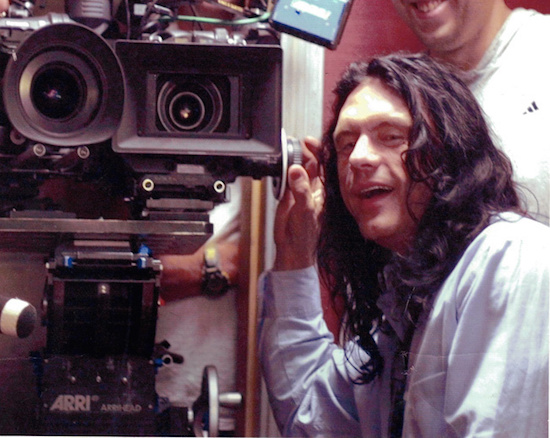
The Disaster Artist is full of anecdotes that testify to Wiseau’s character, or rather testify that his character is as extravagant and bizarre as you’d expect from the film. Wiseau wrote, directed, produced, and starred in The Room. He also financed it, to the tune of $6 million, a cost greatly inflated by some bizarre decision-making on his part: he bought, rather than rented his equipment, and shot on both 35mm film and HD video; he filmed rooftop scenes in a plywood pen against a green screen, on which the San Francisco skyline was composited, even though an actual rooftop was readily available; he constructed a private bathroom for himself, well outfitted but separated from the studio by just a “flimsy curtain.” Maybe he knew what he was doing, but he could only do things his own way, which is several dimensions removed from how people do things. To everyone else, his approach to filmmaking seemed like bathing in Chandon: both frivolous and totally ineffective.
No one really knows where Wiseau came from or how he made his money, but Sestero — who served time as the director’s best, and maybe only, friend — hypothesizes that he was born somewhere in the Communist Bloc and escaped first to France, then to America, where he eventually amassed a fortune through a clothing business called Street Fashions USA. Wiseau, like Sestero, dreamed of becoming an actor, but while Sestero floundered, Wiseau failed miserably. His self-promotional strategies were as terrible as his acting, judged by any objective standard: he wrote a letter to CAA asking, “Do you have the guts to take me?”; sent head shots that were “all professionally done, obviously expensive, and rather scary”; and when over a hundred mail-outs failed to reap even a single response, he sunk into a depression. “I know they don’t want me,” he told Sestero. “I know they don’t understand me. Guy with accent and long hair. So I show them. I show them what I can do.” And with that, he began to write The Room.

Plenty have summarized the film better than I can, but suffice to say it’s a drama about a pure-hearted banker (Johnny, played by Wiseau) whose beloved fianceé (Lisa, played by Juliette Danielle) is cheating on him with his best friend (Mark, played by Sestero). The story is buried under non sequiturs, characters and plot points that appear out of the ether and disappear from whence they came, terrible performances ranging from defeated (Sestero) to wooden (Wiseau) to hysterical (Wiseau), and a script that abides the logic of autocorrect. One famous scene — the first of three sex scenes within the film’s initial half hour — features Wiseau’s bare ass thrusting away at Danielle’s stomach, to a soundtrack of ill-timed moans and warped soft-rock seemingly drawn from the psychic junk drawer between sleep and awake. It’s like anti-heterosexual propaganda.
The film is interesting not just because it’s bad, not just because it’s weird, but because of its particular relationship to the normal, its inexplicable lavishness, its strong aesthetic. “Everyone in the script sounded like Tommy,” Sestero says, remembering the first time he read Wiseau’s completed draft. “‘You have too much competition in the computer field.’ ‘You are not drinking your cognac, dear. It will taste good with pizza.’… Tommy’s life study of human interaction had been put into a Final Draft blender and sprinkled with the darkness of whatever he’d lived through over the last nine months.” Perhaps the eeriest thing about The Room is how the freak at its center compels his average-seeming castmates to speak in his voice, as if by some feat of vampiric mesmerism.

The Room opened in June 2003. It earned $1,800 during its initial, two-week run, but found two evangelists in film students Michael Rousselet and Scott Gairdner, who pioneered its cult. Eventually, a billboard over LA’s Highland Avenue — for which Wiseau paid $5,000 a month, over five years — enticed David Cross, who, according to Entertainment Weekly, introduced the film to comedians Tim Heidecker and Eric Wareheim; Paul Rudd, an early fan, showed it to director David Wain and writer Rob Thomas, who showed it to Kristen Bell, the star of his show Veronica Mars. By decade’s end it was screening in theatres across North America, and audiences had developed a whole call-and-response routine, meaning that if you haven’t seen it yet, you should not see it in the theater.
Wiseau and Sestero have often appeared at screenings, but while the former — who submitted the film for an Academy Award — considers his work a masterpiece, Sestero thinks otherwise. “At the end of the day, [The Room] is just a complete failure on all levels,” he told John Semley in a 2011 Torontoist profile. How could he not feel that way? He witnessed Wiseau fumble aggressively through the whole production, torturing the cast with weird demands and various abuses (when actress Brianna Tate, who was eventually fired, asked during a cast meeting why he’d failed to provide water, “Tommy erupted, yelling, ‘Nobody in Hollywood will give you water!’ before chucking a plastic water bottle at Brianna’s head”). He watched Wiseau flub lines that he’d written himself — lines like, “Oh, hi, Mark” — over and over again, while the crew, which saw considerable turnover, looked on in amusement and deep dismay.
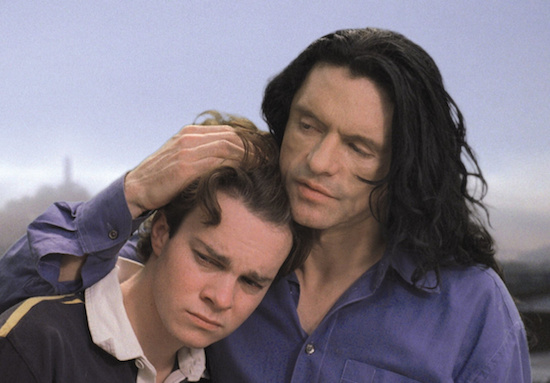
The Disaster Artist is hilarious, but, as with the film, you sometimes feel bad for laughing: despite all the tyranny, it stings to see how much suffering went into the film’s conception and how much heart went into its making. Wiseau and his audience have an arrangement: he accepts their laughter, and they come in droves. (His tagline: “You can laugh, you can cry, you can express yourself, but please don’t hurt each other.”) Does it matter what they’re laughing at? That, of course, is the question at the heart of outsider art. I think about Wesley Willis, and the debate at the time over whether he was being exploited, as well as Shooby Taylor, the “Human Horn,” a New York City postal worker who made his name scatting over gospel, jazz, and classical numbers. An audience is an audience, but watching the clip of him getting booted off Amateur Night at the Apollo is difficult.
I emailed Irwin Chusid, the outsider music expert who wrote about Taylor and Willis in his book Songs in the Key of Z, to ask about the line between mockery and appreciation. “There is often an unintentional comedic value to some outsider art,” he wrote back. “I find Shooby Taylor hysterical. He’s an analgesic for temporary relief of existential pain.” Chusid gushed about Taylor’s many technical virtues (“The high-octane vocal runs, the boundless passion, the sheer absurdity of his choice of scat syllables,” which include, to use Chusid’s spelling, “raw-shaw,” “poppy-poppy,” and “splaw”), and his unmistakable style.
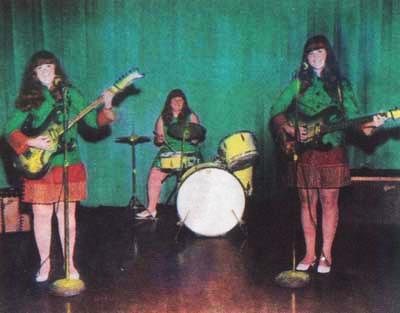
“Is laughing at Shooby Taylor, the Shaggs, or The Room cruel?” he continued. “It could objectively be considered that way, but sometimes it’s just a reflex to art that is so strange, so distant from convention, that you can’t restrain the impulse. After that point, you have to determine whether the performance has any intrinsic value beyond the comic for you.” I asked him what he looked for in an artwork. “A little piece of excitement.”
An artist is anyone who calls himself an artist. But here’s my definition: an artist is someone who manages to push their vision of the world into the world. You can’t evaluate a vision, although you can maybe assess its potency — the more it comes across, the better. As an artist, how you manage this is your call. What The Disaster Artist proves, beyond the seeming absurdity of Wiseau’s decision making, is that all his seemingly absurd decisions served a purpose: The Room is exactly what Tommy Wiseau sees when he watches a blockbuster. Tommy Wiseau thinks the world ought to see what he sees when he watches a blockbuster. Through demented conviction, and deluded self-belief — the sort that might convince you of the artistic merit of doing the Nazi salute in front of an audience full of modern, cosmopolitan Germans — he made us look.
I’m still not really comparing Wiseau to Cohen. But consider another scene, this one from the 1965 NFB documentary Ladies and Gentlemen… Mr. Leonard Cohen, in which an interviewer asks the poet (not yet a rock star) what bothers him in this life. “When I get up in the morning, my real concern is to discover whether or not I’m in a state of grace,” Cohen replies. “And if I make that investigation and I discover that I’m not in a state of grace, I try to go to bed.” Asked for clarification, he continues: “A state of grace is that kind of balance with which you ride the chaos that you find around you. It’s not a matter of resolving the chaos, because there’s something arrogant and warlike about putting the world in order. But having that kind of uh, like an escape ski. Down over a hill. Just going through the contours…” Whether this is profound depends on who’s talking.
CURATED SERIES at HILOBROW: UNBORED CANON by Josh Glenn | CARPE PHALLUM by Patrick Cates | MS. K by Heather Kasunick | HERE BE MONSTERS by Mister Reusch | DOWNTOWNE by Bradley Peterson | #FX by Michael Lewy | PINNED PANELS by Zack Smith | TANK UP by Tony Leone | OUTBOUND TO MONTEVIDEO by Mimi Lipson | TAKING LIBERTIES by Douglas Wolk | STERANKOISMS by Douglas Wolk | MARVEL vs. MUSEUM by Douglas Wolk | NEVER BEGIN TO SING by Damon Krukowski | WTC WTF by Douglas Wolk | COOLING OFF THE COMMOTION by Chenjerai Kumanyika | THAT’S GREAT MARVEL by Douglas Wolk | LAWS OF THE UNIVERSE by Chris Spurgeon | IMAGINARY FRIENDS by Alexandra Molotkow | UNFLOWN by Jacob Covey | ADEQUATED by Franklin Bruno | QUALITY JOE by Joe Alterio | CHICKEN LIT by Lisa Jane Persky | PINAKOTHEK by Luc Sante | ALL MY STARS by Joanne McNeil | BIGFOOT ISLAND by Michael Lewy | NOT OF THIS EARTH by Michael Lewy | ANIMAL MAGNETISM by Colin Dickey | KEEPERS by Steph Burt | AMERICA OBSCURA by Andrew Hultkrans | HEATHCLIFF, FOR WHY? by Brandi Brown | DAILY DRUMPF by Rick Pinchera | BEDROOM AIRPORT by “Parson Edwards” | INTO THE VOID by Charlie Jane Anders | WE REABSORB & ENLIVEN by Matthew Battles | BRAINIAC by Joshua Glenn | COMICALLY VINTAGE by Comically Vintage | BLDGBLOG by Geoff Manaugh | WINDS OF MAGIC by James Parker | MUSEUM OF FEMORIBILIA by Lynn Peril | ROBOTS + MONSTERS by Joe Alterio | MONSTOBER by Rick Pinchera | POP WITH A SHOTGUN by Devin McKinney | FEEDBACK by Joshua Glenn | 4CP FTW by John Hilgart | ANNOTATED GIF by Kerry Callen | FANCHILD by Adam McGovern | BOOKFUTURISM by James Bridle | NOMADBROW by Erik Davis | SCREEN TIME by Jacob Mikanowski | FALSE MACHINE by Patrick Stuart | 12 DAYS OF SIGNIFICANCE | 12 MORE DAYS OF SIGNIFICANCE | 12 DAYS OF SIGNIFICANCE (AGAIN) | ANOTHER 12 DAYS OF SIGNIFICANCE | UNBORED MANIFESTO by Joshua Glenn and Elizabeth Foy Larsen | H IS FOR HOBO by Joshua Glenn | 4CP FRIDAY by guest curators
